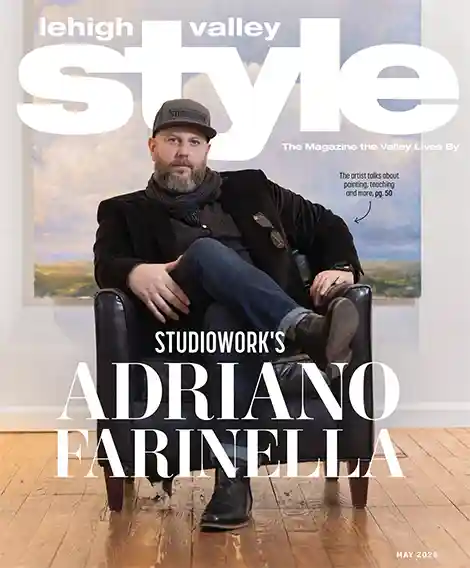




During the mid-1990s, Chris Cree may have been the most popular person at the apartment building where he lived in Lambertville, NJ. Well, its most popular among the resident oenophiles, anyway. At the time, Cree was neck deep—figuratively speaking, of course—in reds and whites as he worked his way through the Master of Wine (MW) program. He frequently shared the residuals of his studies with his neighbors by leaving bottles of wine on their doorsteps. “They loved it,” says Cree. “I was like the wine fairy.” Those well-supplied neighbors may have been the only ones who were just a tad disappointed when Cree successfully earned the MW distinction, and the free vino dried up. For Cree, who now owns Cree Wine Company, a wine bar and restaurant in Hampton, NJ, it was a career-defining moment that catapulted him into elite company. According to the Institute of Masters of Wine, the agency that puts aspiring MWs through their paces, Cree shares his credentials with just 416 others in the world.
"There’s science, there’s farming, there’s business, there’s art. It’s really amazing."
Cree was born in Plainfield, NJ, but considers Hunterdon County, where he moved with his family in sixth grade, the place where he grew up. Naturally, he wasn’t swigging rosé from his toddler cup; one can never say they were truly born an oenophile. But Cree did develop a palate for finer foods at a young age. He recalls cooking with his mother and watching original celebrity chefs Julia Child and the Galloping Gourmet on television. The flavors of faraway lands became a lot more accessible when his mother got remarried to a pilot for Trans World Airlines (TWA). “Suddenly the world opened up,” Cree says. “We could fly for free. Here was this guy when he came home from work, he was coming home from Milan and Paris and wherever in the world.” And he didn’t come home empty-handed—he came bearing gifts of cheeses, truffles and freshly made breads. Cree describes the family dinner table as European style; when he and his siblings—there were six of them total in the blended family— reached their teenage years, they might be treated to a taste of wine with dinner.
It didn’t take long for his interest in wine to take root. Cree was keen on getting a job at a liquor store in Flemington, NJ, as soon as he turned 18 years of age: “I bothered them every single day until they hired me.” Eventually, he was given free rein to establish and manage an in-store wine department. The timing, it seemed, was fortuitous. “It was the beginning of the American wine boom,” says Cree. “Americans really woke up to wine and it became a bigger part of their lifestyle.”
Cree stayed at the liquor store for several years, socking money away for what he assumed would come next: college, and landing a “real” job. But at the same time, he was taking advantage of his TWA travel privileges to visit as many wineries as he could. He made stops all over Europe, as well as the western United States. But he wasn’t kicking back in the tasting room with his nose in a full-bodied merlot. Cree wanted to get his hands dirty—literally. He worked during a harvest to learn the craft of making and selling wine from all angles. “There’s science, there’s farming, there’s business, there’s art. It’s really amazing,” Cree says. And suddenly wine wasn’t just a stepping stone on the way to something else. “It became not just a hobby but a profession,” says Cree.
He left his job at the liquor store in 1984. Over the next several years he worked in various facets of the wine business, including sales, marketing and importing/ exporting. Then in 1993 he decided the time had come to truly test his mettle among the human encyclopedias of the wine world.
The Master of Wine isn’t an academic degree. It’s a designation that is among the most respected titles in the world within that realm. It’s conferred by the London-based Institute of Masters of Wine (IMW), which traces its roots all the way back to the Wine and Spirit Association and the Vintners’ Company in fourteenthcentury England. According to IMW’s website, soon after World War II, both groups wanted to improve the standard of education in the British wine trade, so they came up with an exam to test the best of the best. Of the 21 people in that initial class in 1953, six passed the exam. The IMW began in earnest two years later.
Several notable moments stand out on the timeline between then and now; Cree directly benefited from two of them. In the 1980s, the exam was opened to anyone outside of the United Kingdom. Then, in 1992, the exam was administered on three continents for the first time, including the United States. Suddenly, Cree didn’t have to cross an ocean to put his palate to the test.
The MW program is a multiyear commitment. It is, in a word, intense. Cree was well aware of the stats. “The joke is, the pass rate is something between five percent and never,” he says. There are several components, including an extensive research paper and a blind taste test in which candidates must be able to enumerate on the variety, origin, commercial appeal, craftsmanship, quality and style of a dozen different samples of wine. “I had thousands and thousands of index cards with every topic of wine and bullet points about how you would answer an essay question about this,” Cree says. But he also felt buoyed by his many travels through wine country: “There’s so much of this you can’t learn in books. You have to learn by talking to winemakers and seeing what is this guy doing, versus his neighbor, versus a guy halfway around the world.”
His method worked. In 1996 Cree became just the 13th American to earn the distinction of being called a Master of Wine. He remains New Jersey’s sole MW; there are none in Pennsylvania. Even though he has earned the right to act the part of the stereotypical wine snob, his goal at his namesake restaurant and wine bar in Hampton, NJ, which he opened in 2021 at the former Perryville Inn, is not pedantry. While he certainly could school anyone in tannins, aeration, tartaric acids and the like, he’s much more interested in making wine accessible to everyone, whether that person’s go-to is a ten-dollar chardonnay or a vintage Romanée-Saint-Vivant that has a price tag in the thousands. And just to make sure Cree Wine Company covers all of those bases, it can boast of a wine list— curated, naturally, by Cree himself—that lands somewhere in the range of 800 to 900 different selections. And for those who do want more of the backstory behind the sip, the place offers tastings and classes as well.
Does Cree, who’s also an avid surfer and skier, and who shares two adult children (Hannah and John) with his wife, Kathleen, ever get tired of drinking wine? The answer is no. Generally. There was a research trip to California years ago, when he had to taste more than 480 cabernets over the course of several weeks. Afterward, he thought: “I need either icecold beer or ice-cold French rosé. It’s all I could handle at that point. It was an assault on the palate.”
And does Cree have an all-time favorite wine? Again, the answer is no. Generally. He does lean toward Old World wines— think French, Italian and Spanish. He also appreciates wines that tell a story. “Wines that capture and express the terroir and the place that they come from are to me the most fascinating,” says Cree.
Published as “Insight” in the Novemeber 2024 edition of Lehigh Valley Style magazine.
















